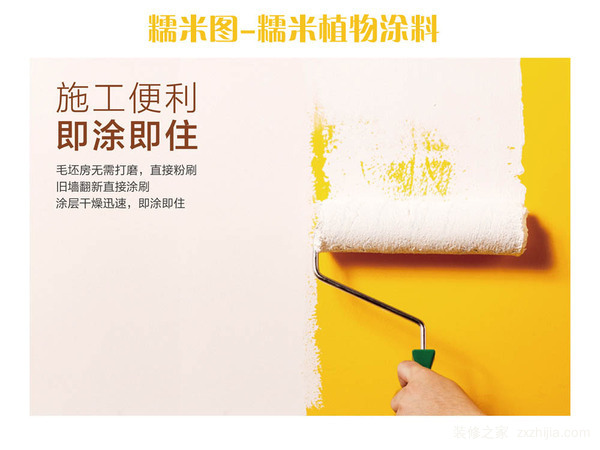Environmentally friendly water-based paints are in the ascendant. With the gradual improvement of people's living standards, the use of paints has been on the rise. The paints used before are the most common, only the effect of whitening walls. After the development of technology, environmentally friendly paints have emerged. Once progress, there will be environmentally friendly water-based paints, and then Xiaobian will take you to look at the exciting content of environmentally-friendly water-based paints. First, the development of water-based coatings market 1. The development of waterborne wood coatings in China has experienced a difficult journey for more than 10 years, and its industrialization is still far away. The China Coatings Industry Association held the first waterborne wood coating development seminar in Guangzhou to promote the development, promotion and application of waterborne wood coatings in China. 2. According to reports, although the industry association is committed to the promotion of water-based wood coatings, there are many domestic coating companies to participate in the exhibition, but there are many companies waiting to see, but few want to get involved. This phenomenon is aptly called "industry heat, market cold" by the people involved in the paint association. The promotion of waterborne wood coatings is very beneficial for the rational use of resources and the improvement of environmental sanitation. 3. Due to the operability of waterborne wood coating construction, domestic well-known decoration companies intend to use water-based wood coatings comprehensively, and train painters to set up corresponding construction teams to initiate water-based sports. Today, with the increasing emphasis on coating safety and environmental protection indicators, waterborne wood coatings are gradually accepted by the market because of their low-harm and low-pollution characteristics. 4. Waterborne wood coating is the development direction of the future wood coatings market. It is undoubted that the demand for safe production of enterprises, the improvement of employees' safety awareness, the improvement of labor costs, the importance of raw materials enterprises in the research and development of waterborne wood coatings, and the development of coatings enterprises. Waterborne wood coatings and other factors have contributed to the irreversible development of waterborne wood coatings. First, the guidance of government policies; second, the popularity and demand of environmental protection concepts; third, the need for enterprise transformation and upgrading. Second, water-based paint operation skills Tip 1: Use a clean water to adjust the viscosity of the paint to a suitable spray, measured with a viscous-4 viscometer. The appropriate viscosity is typically 20 to 30 seconds. If there is no viscometer at one time, visual method can be used: stir the paint with a rod (iron rod or wooden stick) and pick it up to a height of 20 cm to stop and observe. If the paint liquid is continuous in a short time (a few seconds), It is too thick; if it is off the edge of the barrel, it is too thin; when it is just 20 cm high, the paint liquid is in a straight line, and the instantaneous flow is turned into a downward drop. This viscosity is more suitable. Tip 2: The air pressure is best controlled at 0.3-0.4 MPa (3-4 kgf/cm2). If the pressure is too small, the spray liquid will be atomized, and the surface will form pitting. If the pressure is too large, it will sag and the paint mist will be too large, which will waste materials and affect the health of the operator. Tip 3: The distance between the nozzle and the object surface is generally 300-400 mm. It is easy to sag too close; the paint mist is not uniform too far, and it is prone to pitting, and the nozzle is far away from the object surface and the fog is scattered on the way. The specific size of the distance should be appropriately adjusted according to the type of paint, viscosity and pressure. Slow drying paint spraying distance can be a little farther, quick-drying paint spraying, the distance can be closer; when the viscosity is thick, it can be closer, when the viscosity is thin, the distance can be farther; when the air pressure is large, the distance can be farther, the pressure can be closer; the so-called A little closer is a small adjustment between 10 mm and 50 mm. If it exceeds this range, it is difficult to obtain a desired paint film. Tip 4: The spray gun can be moved up and down, left and right, preferably at a speed of 10-12 m / min. The nozzle should be sprayed straight to the surface to minimize the oblique spray. When spraying to both ends of the object surface, the hand of the trigger of the spray gun should be loosened quickly to reduce the paint mist, because the two ends of the object surface often need to be sprayed twice or more, which is the most likely place for sag. Tip 5: When spraying, press the next one to hold 1/3 or 1/4 of the previous one, so that there will be no leakage. When spraying the quick-drying paint, it is necessary to spray it in sequence. The effect of refilling is not ideal. Tip 6: When spraying in an open space, pay attention to the wind direction (not suitable for operation in high winds). The operator should stand in the downwind direction to prevent the paint mist from being blown onto the sprayed paint film to create an unsightly grainy surface. Tip 7: The order of spraying is: first difficult and easy, first inside and outside. After the height is high, the small area is small. This will not cause the spray mist of the Post -spray to splash onto the sprayed paint film and destroy the sprayed paint film. The above is the introduction of the relevant content of environmentally friendly water-based paints. I hope that readers will be able to see and hear, and you will benefit from the application in real life. Well, today's introduction to environmentally friendly water-based paints is here. Thanks to readers and friends for reading this article and for their support and love for small series. If you want to get more home improvement information, please continue to pay attention to the decoration home. network. More related wonderful reading: Advantages of waterborne coating formulations for waterborne coating formulations What is the difference between solvent-based and water-based paints? Introduction to Waterborne Coating Dispersants The Role of Waterborne Coating Dispersants What is waterborne paint? What are the advantages of waterborne coatings? What is waterborne paint? Introduction of the role of waterborne coatings
Woven Fence are weaved by galanized Wire , PVC wire or Stainless steel wire.
The woven fence contains Chain link fence, Field fence , Gabion , Bullet-Proof Mesh
1. Chain Link Fence is extensively used as fences for playground and gardens, super highway, railway, airport, port, residence, etc. Also can be used for breeding of animals.
Chain link fence can be with barb wire, Razor Wire on top for high security.
2. Field Fence also called Grassland garden mesh(Hinge Joint Fence) usually made from hot dip galvanized wire with zinc coating of 230g/m2.
Top and bottom wire: 2.5mm
inner wire: 2.0mm
3. Gabion Basket made of hexagonal Galvanized/PVC/Zinc-Al double twised mild steel wire mesh.
Gabion baskets can be supplied in various lengths, widths and heights. In order to strengthen the baskets, all the edges of the structure shall be selvedged thicker wire diameter.
4. Bullet-proof mesh is the most popular as window screen. It made of stainless steel wire and powder coating.
The Bullet-proof mesh transparent without any sense of vertigo, it is like a layer of transparent colored glass when looked from inside to the outside of the rom and hazy and blurred from outside to the inside of the room.
Woven Fence Chain Link Fence,Field Fence,Bullet-Proof Mesh,Woven Fence Anping Deming Metal Net Co.,Ltd , https://www.wovenfence.nl
